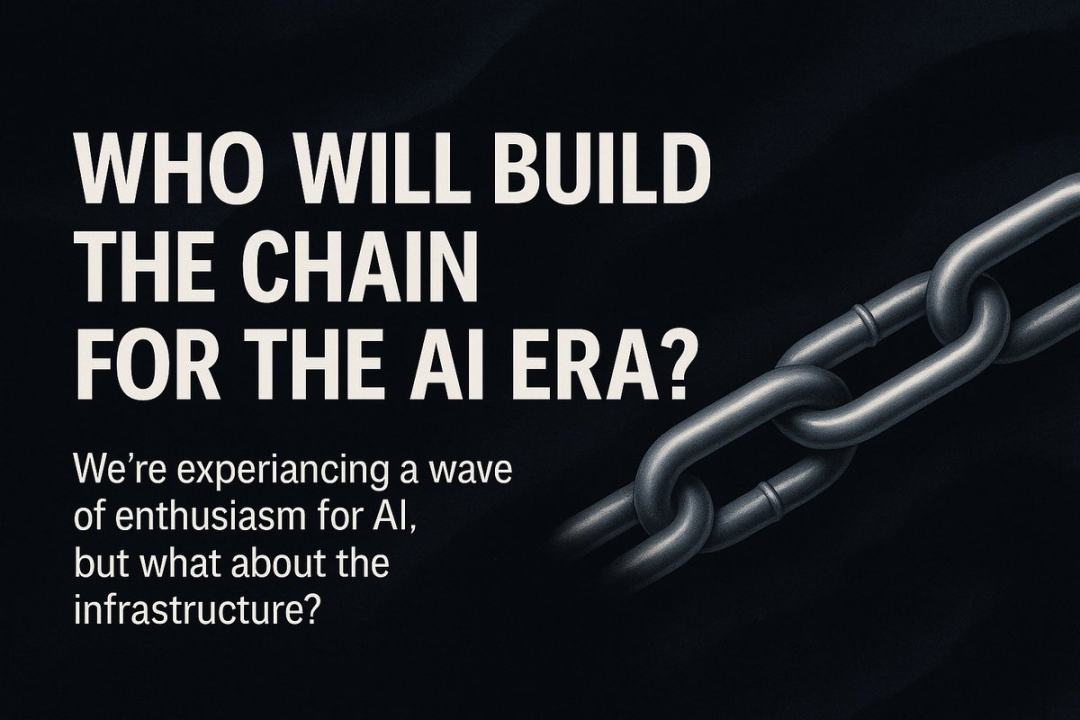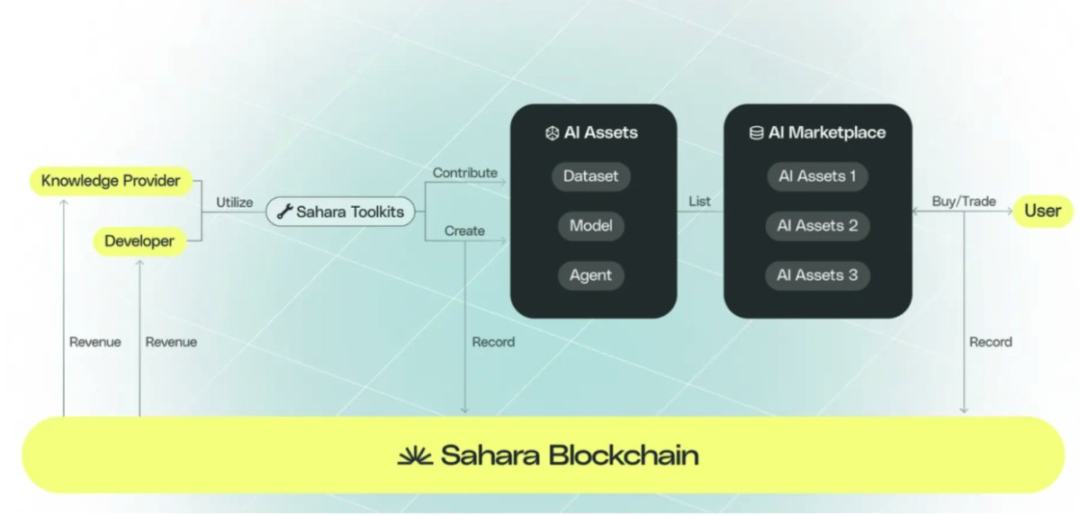No matter which route the project takes, it ultimately has to enter the collaborative logic of AI, using AI to enhance competitiveness and efficiency.
Written by: jiayi
When the technological paradigm truly shifts, we often first see the hype, rather than the system.
The AI wave we are experiencing is no different.
As a primary investor, I have always believed that betting on the transformative forces deep within the industry is far more worthwhile than chasing superficial narratives.
In the past year, I have seen a large number of projects in RWA, Consumer, infoFi, and many others—undoubtedly exploring the intersection of the real world and on-chain systems.
But an increasingly obvious trend is: no matter which route the project takes, it ultimately has to enter the collaborative logic of AI, using AI to enhance competitiveness and efficiency.
For example, in RWA, thinking about how to use AI for risk control optimization, off-chain data verification, and dynamic pricing is the future;
Or for Consumer or DeFi, which urgently need excellent user experiences, AI is also needed to accomplish user behavior prediction, strategy generation, incentive distribution, and other similar directions that I won't elaborate on further.
Therefore, whether it is asset digitization or experience optimization, these seemingly independent narratives will eventually converge into the same technological logic: if the infrastructure does not possess the ability to integrate and support AI, it cannot sustain the complex collaboration of the next generation of applications.
In my view, the future of AI is not just about being "stronger and stronger" and "used more and more"; the real paradigm shift lies in the reconstruction of collaborative logic.
Just like the early transformations of the internet, it was not because we invented DNS or browsers, but because it allowed everyone to participate in content creation, turning ideas into products, thus giving rise to an entire open ecosystem.
AI is also on this path: Agents will become everyone's intelligent co-creation entities, helping you turn expertise, creativity, and tasks into automated productivity tools, even monetizing them.
This is a question that the current Web2 world finds difficult to answer, and it is also some of the underlying logic I see in the AI + Web3 track: making AI collaborative, circulatable, and profit-sharing is the truly worthwhile system to build.
What I want to talk about today is the only project so far that attempts to systematically build the underlying operations of AI from a chain-level structure: Sahara.
(Note: I am not from the Sahara team, but as an investor in Sahara for two consecutive rounds, I have accompanied the project for nearly two years, witnessing advantages and potential beyond the public perspective, but it inevitably carries subjective expectations.)

The essence of investment is a worldview, a value system of choice
My investment logic is not about the narrative of public chains plus AI, then seeing which team looks better on paper and placing a bet.
Investment, at its core, is a choice of worldview, and I have always been asking a core question: Can the future of AI be jointly owned by more people?
Can it leverage blockchain to reconstruct the value attribution and distribution logic of AI, allowing ordinary users, developers, and other roles to have the opportunity to participate, contribute, and continuously benefit? It’s simple: only with the emergence of this logic do I believe such projects have the potential to be disruptors, rather than just "abandoned public chains +1."
To find the answer, I have basically scanned all the AI projects I could access until I encountered Sahara. The answer given to me by Sahara's co-founder Tyler was: to build an open, participatory ecosystem that everyone can own and benefit from.
This statement is simple, but it precisely hits the soft spot of traditional public chains: they often serve developers unidirectionally, and the token economic design is mostly limited to Gas Fees or governance, rarely able to truly support the positive cycle of the ecosystem, and even harder to sustain the development of an emerging track.
I am well aware that this path is full of challenges, but precisely because of this, it is an irresistible revolution—which is also the reason for my firm investment.
As I emphasized in my previous article discussing the "evolution from Web2 to Web3": the real paradigm shift is not about creating a single product, but about building a supportive system. (Readers interested in this logic are welcome to refer to that article.)
And Sahara is one of the most anticipated cases in my previous predictions.

From investment to an 8x valuation follow-up
If I initially invested in Sahara because it was doing what I believe to be the true leading mission of AI—building AI economy and infrastructure systems, then what made me rush to follow up with an 8x investment in just six months was the rare strength I felt from this team.
The two co-founders include one of the youngest tenured professors at USC, specializing in AI. I believe the value of a tenured professor in their 30s is not only in academia but also in the fact that at this age, they still have dreams, energy, and the courage to realize those dreams. Knowing Professor Ren for over a year has shown me what it means to work for more than ten hours a day, maintain emotional stability, and be a humble genius.
Tyler, the former investment director at BN Lab, was responsible for North American investments and incubators, and his understanding of web3 goes without saying. He is astonishingly disciplined: he only sleeps in multiples of 1.5 hours, insists on working out no matter how busy he is to maintain his condition, and avoids sugar to keep his mind clear, working over 13 hours a day. I once joked that he is a robot, and he simply replied: "I am lucky to have the busy life I have today." His source of dopamine is advancing project progress every day; dreaming is his passion, needing no other fuel.
I am grateful to have met them; it has changed me. I have also finally started to regulate my sleep as much as possible, gradually stabilizing my emotions, and working out…
So when someone says Sahara gained capital's favor due to luck, I will unreservedly add, "The capital's pursuit is a natural result." I vividly remember how difficult it was to raise this round of primary market financing, but Sahara was chased by the primary market for investment.
What everyone remembers is that Polychain, Binance, and Pentera invested in Sahara. Sahara has opened the investment era for Samsung's entry into the Web3 AI field, and its receipt of the Samsung AI Award was a significant reason for Samsung's investment. In addition, some heavily invested AI funds and national banks are also guests of Sahara. You can see a group of more traditional technology and industry resource institutions quietly betting on AI × Web3 because of Sahara.
Capital will only pay for certainty in direction and execution—this is the positive feedback on Sahara's technical depth, team background, system design, and execution capability.
This is also why it can achieve some real and solid structural indicators:
Over 3.2 million accounts have been activated on the testnet, with over 200,000 data platform annotators (with millions in the queue), and their clients include leading companies like Microsoft, Amazon, Character.AI, Motherson, etc., already achieving revenue in the tens of millions of dollars.
On this infrastructure chain, at least from "who will do it" to "can it be done," Sahara has already gone deeper and steadier than 99% of the "AI Narrative projects."

The ultimate question for public chains: allowing all contributors to continuously benefit and drive positive economic cycles
Returning to our initial judgment logic: in the system combining AI and blockchain, is there really a mechanism that can make every contributor seen, recorded, and continuously rewarded?
Model training and data optimization rely on a large amount of annotation and interaction support; conversely, if there is a lack of user contributions, the project itself has to invest more funds to procure data and outsource annotations, which not only increases costs but also weakens the value-driven community co-construction.
Sahara is one of the few Web3 AI projects that allows ordinary users to "participate in data construction from day one." Its data annotation task system operates daily, with a large number of community users actively participating in annotations and prompt creation. This not only helps improve the system but also invests in the future with data.
Through Sahara's mechanism, it not only enhances model quality but also allows more people to understand and participate in this decentralized AI ecosystem, linking data contributions with rewards, forming a true virtuous cycle.
A typical example is the Myshell project on BNB Chain, which quickly built a high-quality dataset covering multiple languages and accents through Sahara's decentralized data collection and human-machine collaborative annotation, significantly improving the training efficiency of its TTS and voice cloning models. This also propelled its open-source projects like VoiceClone and MeloTTS to receive thousands of GitHub stars and over 2 million downloads on Hugging Face.
At the same time, users participating in data annotation also received token rewards issued by Myshell, forming a two-way incentive loop between developers and data contributors.
Sahara's "permissionless copyright" mechanism ensures the rights of all participants while guaranteeing the open circulation and reuse of AI assets—this is the underlying logic driving the explosive growth of the entire ecosystem.
Why is this a scenario with long-term value support?
Imagine if you want to build an AI application, you naturally hope your model is more accurate and closer to real users than others.
Sahara's key advantage is that it connects you with a vast and active data network—hundreds of thousands, potentially millions of annotators in the future. They can continuously provide you with customized, high-quality data services, allowing your model to iterate faster than others.
More importantly, this is not a one-time transaction. Through Sahara, you are connecting to a potential early user community; and these contributors are likely to become your product's real users in the future.
This connection is also not a one-time buyout; through Sahara's smart contract system and rights confirmation mechanism, it enables a long-cycle, traceable, and sustainable incentive system.
No matter how many times the data is called, contributors will receive continuous profit sharing, with earnings dynamically linked to usage behavior.
But this is not just a revenue model for the data annotation and model training stages. Sahara is building an economic system that covers the entire lifecycle of AI models, with built-in profit-sharing mechanisms at every stage of model deployment, combination, and cross-chain reuse, allowing value to be captured over a longer period.
Model developers, optimizers, validators, computing power contribution nodes, and others can now continuously benefit at different stages, rather than relying solely on one-time transactions or buyouts.
Such a system brings a compound interest effect to model combination calls and cross-chain reuse. A well-trained model can be repeatedly called and combined by different applications, with each call generating new revenue for the original contributors.
For this reason, I resonate with Sahara's underlying belief: a truly healthy AI economic system cannot be merely about data plundering or model buyouts, nor can it allow a few individuals to reap all the benefits. It must be open, collaborative, and win-win—where everyone can participate, every valuable contribution can be recorded, and continuous returns can be obtained in the future.

But the closer we get to the real structure, the more challenges arise
Although I am optimistic about Sahara, I will not hide the challenges the project will face due to my investment position.
One major advantage of Sahara's architecture is that it is not limited to a specific chain or single ecosystem.
From the beginning, its system was designed to be open, cross-chain, and standardized: it supports deployment on any EVM-compatible chain and also provides standard API interfaces, allowing Web2 systems—whether e-commerce backends, enterprise SaaS, or mobile apps—to directly call Sahara's model services and complete on-chain settlements.
However, despite the extreme rarity of such architectural design, it carries a core risk: the value of the infrastructure lies not in "what it can do", but in "who is willing to do what based on it."
To become a trusted, adopted, and combinable AI protocol layer, Sahara's key lies in how ecosystem participants assess its technological maturity, stability, and future predictability. Although the system itself has been built, whether it can truly attract a large number of projects to land based on its standards remains uncertain.
Undeniably, Sahara has achieved key validations: serving leading companies like Microsoft, Snapchat, MIT, Motherson Group, and Amazon, providing them with relevant data services and addressing some of the industry's most challenging data needs, becoming an early signal validating the feasibility of this system.
However, it is important to note that these collaborations mainly come from the Web2 world. The true determinant of Sahara's long-term development will still be the maturity and penetration of the entire Web3 AI track. Sahara benefits from the overarching trend of Web3 AI, but to truly unleash the value of its infrastructure, it still requires more Web3-native AI products and technological solutions to be implemented and perfected.
But let’s not forget, Sahara is currently "the only one of its kind."
In the track of chain-level infrastructure designed specifically for AI, although there are many imitators proposing conceptual frameworks, so far, only Sahara has achieved comprehensive implementation from on-chain rights confirmation, off-chain execution, cross-chain calls to technical closed loops and real revenue, validated by actual clients.
This not only gives Sahara a "monopoly advantage", but also brings structural risks: once successful, it will define the industry benchmark for the entire Web3 × AI Infra; but if it fails, it may lead to AI Layer1 being viewed as a premature layout.
Since it is currently the only choice in this field, the market's judgment on it will naturally be more stringent and rational—it must withstand the test of time and the ecosystem.

Finally, a message to all builders and observers | Seize the window of the building period, rather than regret waiting for it to take shape
For me, the core of every primary investment decision rests on three things: the depth of understanding of the world, the dimensions of trend judgment, and the willpower of the team to traverse cycles. Products and features are certainly important, but they often merely reflect these underlying cognitions.
Web3 is not lacking in ideas or stories; what it lacks is the hands to turn logic into order, and the people who truly know what to persist in and what to abandon.
I cannot guarantee whether Sahara can become the next paradigm-level chain.
But it is indeed the only attempt worth serious consideration, observation, and investment at present.
If you are waiting for the day when everything runs smoothly, the ecosystem takes shape, and industry consensus is established—then the opportunity will no longer belong to you.
So, perhaps you should really panic. Not because you missed something, but because you just happened to hit a moment when the system is just beginning.
While others are still watching and waiting for the market to provide clear signals, you already know that this system exists, the direction is clear, and the structure has been established, only that no one truly understands it yet.
Most people will flock to it after it runs smoothly, while you—at this moment—are standing at a point where the flywheel has yet to start, and the standards have yet to be defined.
This is not a certain opportunity, but it is a real beginning.
Not everyone can understand it, but you have already seen "what is ahead of consensus."
免责声明:本文章仅代表作者个人观点,不代表本平台的立场和观点。本文章仅供信息分享,不构成对任何人的任何投资建议。用户与作者之间的任何争议,与本平台无关。如网页中刊载的文章或图片涉及侵权,请提供相关的权利证明和身份证明发送邮件到support@aicoin.com,本平台相关工作人员将会进行核查。




